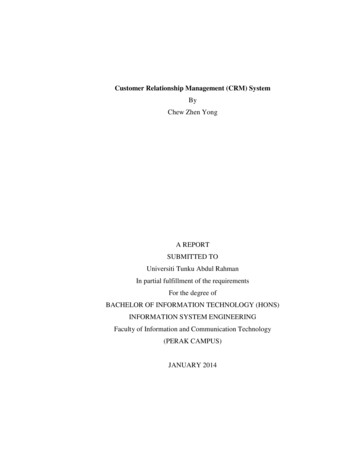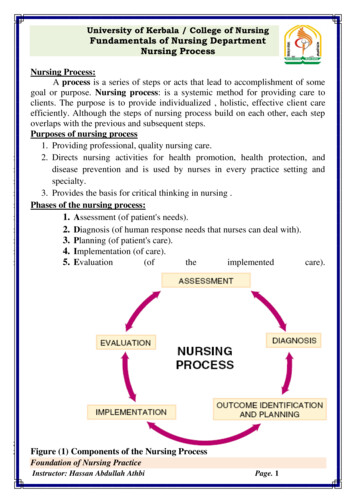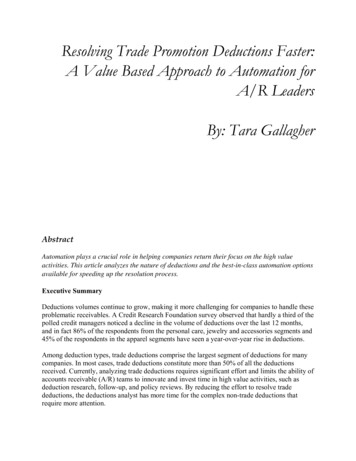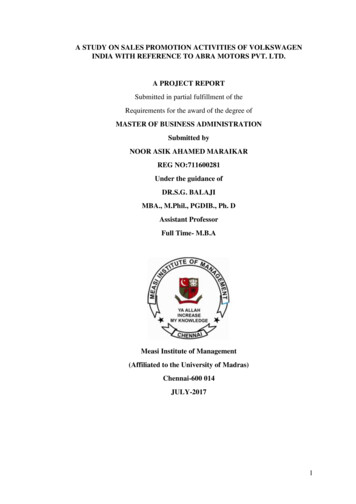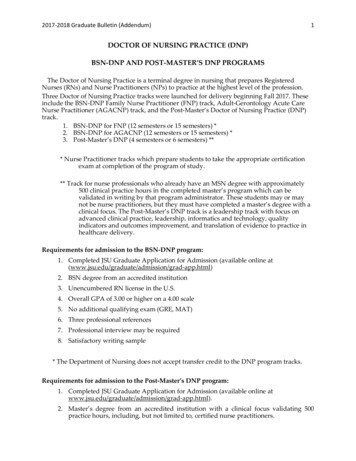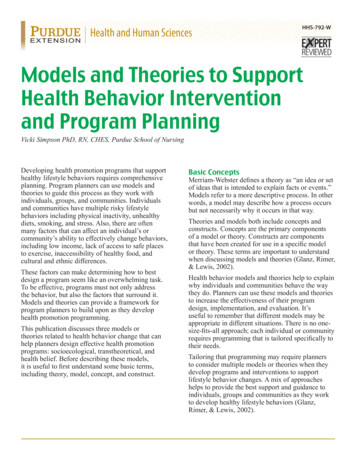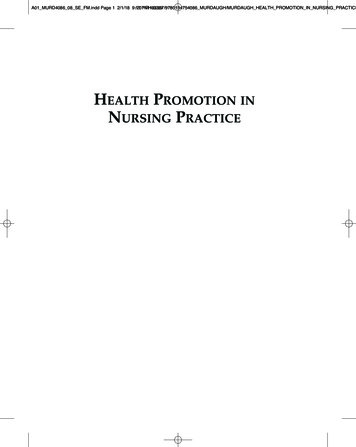
Transcription
A01 MURD4086 08 SE FM.indd Page 1 2/1/18 9:17/207/PH03387/9780134754086 MURDAUGH/MURDAUGH HEALTH PROMOTION IN NURSING PRACTICEPM f-0039Health Promotion inNursing Practice
A01 MURD4086 08 SE FM.indd Page 2 2/1/18 9:17/207/PH03387/9780134754086 MURDAUGH/MURDAUGH HEALTH PROMOTION IN NURSING PRACTICEPM f-0039
A01 MURD4086 08 SE FM.indd Page 3 2/1/18 9:17/207/PH03387/9780134754086 MURDAUGH/MURDAUGH HEALTH PROMOTION IN NURSING PRACTICEPM f-0039Eighth EditionHealth Promotion inNursing PracticeCarolyn L. Murdaugh, PhD, RN, FAANProfessor Emerita and Adjunct ProfessorUniversity of ArizonaCollege of NursingTucson, ArizonaMary Ann Parsons, PhD, RN, FAANProfessor Emerita and Dean EmeritaUniversity of South CarolinaCollege of NursingColumbia, South CarolinaNola J. Pender, PhD, RN, FAANProfessor EmeritaUniversity of MichiganSchool of NursingAnn Arbor, Michigan330 Hudson Street, NY, NY 10013
A01 MURD4086 08 SE FM.indd Page 4 2/1/18 9:17/207/PH03387/9780134754086 MURDAUGH/MURDAUGH HEALTH PROMOTION IN NURSING PRACTICEPM f-0039Vice President, Health Science and TED: Julie LevinAlexanderDirector, Portfolio Management and PortfolioManager: Katrin BeacomEditor in Chief: Ashley DodgePortfolio Management Assistant: Erin SullivanAssociate Sponsoring Editor: Zoya ZamanProduct Marketing Manager: Christopher BarryField Marketing Manager: Brittany HammondVice President, Digital Studio and ContentProduction: Paul DeLucaDirector, Digital Studio and Content Production:Brian HylandManaging Producer: Jennifer SargunarContent Producer (Team Lead): Faraz Sharique AliContent Producer: Neha SharmaManager, Rights Management: Gina CheselkaOperations Specialist: Maura Zaldivar-GarciaCover Design: Cenveo Publisher ServicesCover Art: dharshani Gk-arts/123RFFull-Service Management and Composition:iEnergizer Aptara , Ltd.Printer/Binder: LSC CommunicationsCover Printer: LSC CommunicationsText Font: Palatino LT Pro 10/12Copyright 2019, 2015, 2011 by Pearson Education, Inc. All Rights Reserved. Manufactured in the United States ofAmerica. This publication is protected by copyright, and permission should be obtained from the publisher prior to anyprohibited reproduction, storage in a retrieval system, or transmission in any form or by any means, electronic, mechanical,photocopying, recording, or otherwise. For information regarding permissions, request forms, and the appropriate contactswithin the Pearson Education Global Rights and Permissions department, please visit www.pearsoned.com/permissions/.Acknowledgments of third-party content appear on the appropriate page within the text.Unless otherwise indicated herein, any third-party trademarks, logos, or icons that may appear in this work are theproperty of their respective owners, and any references to third-party trademarks, logos, icons, or other trade dress are fordemonstrative or descriptive purposes only. Such references are not intended to imply any sponsorship, endorsement,authorization, or promotion of Pearson’s products by the owners of such marks, or any relationship between the owner andPearson Education, Inc., authors, licensees, or distributors.Library of Congress Cataloging-in-Publication DataNames: Murdaugh, Carolyn L., author. Parsons, Mary Ann, author. Pender, Nola J., 1941– author.Title: Health promotion in nursing practice / Carolyn L. Murdaugh, PhD, RN, FAAN, Professor Emerita and AdjunctProfessor, University of Arizona, College of Nursing, Tucson, Arizona, Mary Ann Parsons, PhD, RN, FAAN, ProfessorEmerita and Dean Emerita, University of South Carolina, College of Nursing, Columbia, South Carolina, Nola J. Pender,PhD, RN, FAAN, Professor Emerita, University of Michigan, School of Nursing, Ann Arbor, Michigan.Description: Eighth edition. Boston : Pearson, [2019] Revised edition of: Health promotion in nursing practice /Nola J. Pender, Carolyn L. Murdaugh, Mary Ann Parsons. Seventh edition. [2015]. Includes bibliographical referencesand index.Identifiers: LCCN 2017061583 ISBN 9780134754086 ISBN 0134754085Subjects: LCSH: Health promotion. Preventive health services. Nursing.Classification: LCC RT67 .P56 2019 DDC 613--dc23 LC record available at https://lccn.loc.gov/2017061583118ISBN 13: 978-0-13-475408-6ISBN 10: 0-13-475408-5
A01 MURD4086 08 SE FM.indd Page 5 2/1/18 9:17/207/PH03387/9780134754086 MURDAUGH/MURDAUGH HEALTH PROMOTION IN NURSING PRACTICEPM f-0039DedicationTo nurse educators and practicing nurses who teach and role modelhealth promotion. I bid you success as you face the challenges ofpromoting a culture of health for all.— C. MurdaughTo my family and friends for their support during the preparation ofthis edition; I wish all of you happy and healthy lives.—M. A. Parsons
A01 MURD4086 08 SE FM.indd Page 6 2/1/18 9:17/207/PH03387/9780134754086 MURDAUGH/MURDAUGH HEALTH PROMOTION IN NURSING PRACTICEPM f-0039
A01 MURD4086 08 SE FM.indd Page 7 2/1/18 9:17/207/PH03387/9780134754086 MURDAUGH/MURDAUGH HEALTH PROMOTION IN NURSING PRACTICEPM f-0039CONTENTSForeword xviiPreface xixIntroduction: Health Promotion in a Changing Social and DigitalEnvironment 1Part 1 The Human Quest for Health7Chapter 1 Toward a Definition of Health8Health as an Evolving Concept 9Definitions of Health that Focus on Individuals 11Health as Stability 11Health as Actualization 12Health as Actualization and Stability 13Health as an Asset 15An Integrative View of Health 15Definitions of Health that Focus on the Family 16Definitions of Health that Focus on the Community 17Social Determinants of Health 18Social Determinants and Global Health 19Building a Culture of Health 20Conceptions of Health Promotion 21Measurement of Health 24Considerations for Practice in the Context of Health 25Opportunities for Research On Health 25Summary 26 Learning Activities 26 References 26Chapter 2 Individual Models to Promote Health Behavior30Individual Potential for Change 31Use of Theories and Models for Behavior Change 31Social Cognition Theories and Models 32The Health Belief Model 33Theory of Reasoned Action and Theory of Planned Behavior 35Self-Efficacy and Social Cognitive Theory 37The Health Promotion Model 40Theoretical Basis for the Health Promotion Model 40vii
A01 MURD4086 08 SE FM.indd Page 8 2/1/18 9:17/207/PH03387/9780134754086 MURDAUGH/MURDAUGH HEALTH PROMOTION IN NURSING PRACTICEPM f-0039viiiContentsThe Health Promotion Model (Revised) 40Individual Characteristics and Experiences 40Behavior-Specific Cognitions and Affect 42Commitment to a Plan of Action 44Immediate Competing Demands and Preferences 44Behavioral Outcome 44Stage Models of Behavior Change 45Transtheoretical Model 45Theories of Health Behavior in the Digital Age 47Theories of Persuasion and Digital Health Technologies 48Persuasive Technology 48Strategies for Health Behavior Change 49Setting Goals for Change 49Monitoring Progress Toward Goals to Promote Change 50Promoting Self-Efficacy 51Enhancing Benefits of Change 52Managing Barriers to Change 52Tailoring Communication for Behavior Change 53Behavior Change Strategies in Persuasive Technology 55Ethics and Health Behavior Change 56Considerations for Practice in Health Behavior Change 57Opportunities for Research with Health Behavior Theories andModels 57Summary 58 Learning Activities 58 References 58Chapter 3 Community Models to Promote Health63The Concept of Community 64Community Interventions and Health Promotion 65Community Social-Ecological Models and Theories 67Social-Ecological Model 67Social Capital Theory 70Community Planning Models for Health Promotion 72The PRECEDE–PROCEED Model 72Community Dissemination Models to Promote Health 74Diffusion of Innovations Model 74Social Marketing Model 78Considerations for Practice Using Community Modelsof Health 80
A01 MURD4086 08 SE FM.indd Page 9 2/1/18 9:17/207/PH03387/9780134754086 MURDAUGH/MURDAUGH HEALTH PROMOTION IN NURSING PRACTICEPM f-0039ContentsOpportunities for Research with Community-Based Models 80Summary 81 Learning Activities 81 References 82Part 2 Planning for Health Promotion and Prevention85Chapter 4 Assessing Health and Health Behaviors 86Emerging Technologies and Nursing Assessment 87Nursing Frameworks for Health Assessment 93Guidelines for Preventive Services and Screenings 95Assessment of the Individual Client 96Functional Health Patterns 96Physical Fitness 96Nutrition 98Life Stress 100Spiritual Health 101Social Support Systems 103Lifestyle 103Assessment of the Family 105Assessment of the Community 107Considerations for Practice in Assessing Healthand Health Behavior 108Opportunities for Research in Health Assessmentand Health Behavior 108Summary 108 Learning Activities 109 References 109Chapter 5 Developing a Health Promotion–Prevention Plan113Health Planning Process 115Review and Summarize Assessment Data 115Emphasize Strengths and Competencies of the Client 115Identify Health Goals and Related BehaviorChange Options 116Identify Desired Health Behavior Outcomes 117Develop a Behavior Change Plan 118Develop a Behavior Change Plan for Low-Literacy, CulturallyDiverse Populations 118Identify Stage of Change and Reinforce Benefitsof New Behavior 120Address Environmental and Interpersonal Facilitatorsand Barriers to Change 124ix
A01 MURD4086 08 SE FM.indd Page 10 2/1/18 9:17/207/PH03387/9780134754086 MURDAUGH/MURDAUGH HEALTH PROMOTION IN NURSING PRACTICEPM f-0039xContentsDetermine a Time Frame for Implementation 124Formalize Commitment to Behavior Change Plan 125Revised Health Promotion–Prevention Plan 126Community-Level Health Promotion–Prevention Plan 126Considerations for Practice in Health Planning 127Opportunities for Research in the Planning Process 128Summary 128 Learning Activities 128 References 128Part 3 Interventions for Health Promotionand Prevention 131Chapter 6 Physical Activity and Health Promotion132Health Benefits of Physical Activity 133Potential Risks of Physical Activity 135Genetics, Environment, and Physical Activity 135Prescribing Physical Activity to Achieve Health Benefits 136Promoting Physical Activity Across the Life Span 138Promoting Physical Activity in Children and Adolescents 139Gender and Physical Activity in Children and Adolescents 139Implementing Guidelines for Physical Activity in Childrenand Adolescents 140Promoting Physical Activity in Families 142Promoting Physical Activity in Schools 142Promoting Physical Activity in Adults and Older Adults 143Racial and Gender Differences in Physical Activity in Adultsand Older Adults 144Implementing Physical Activity Guidelines for Adultsand Older Adults 145Promoting Physical Activity in the Workplace 149Promoting Physical Activity in Persons with Disabilities 149Community Programs to Promote Physical Activity 150The Built Environment and Physical Activity 151Physical Activity Interventions for Diverse Populations 153Technology and the Promotion of Physical Activity 155Nurses as Role Models of Physical Activity Behavior 155Considerations for Practice to Promote Physical Activity 156Opportunities for Research in Physical Activity 157Summary 157 Learning Activities 157 References 158
A01 MURD4086 08 SE FM.indd Page 11 2/1/18 9:17/207/PH03387/9780134754086 MURDAUGH/MURDAUGH HEALTH PROMOTION IN NURSING PRACTICEPM f-0039ContentsChapter 7 Nutrition and Health Promotion161Promoting Healthy Diet and Nutrition 162Nutritional Health of Americans 162Dietary Guidelines for Americans 163Challenges to Dietary Guidelines 165MyPlate: A Visual Guide to Healthy Eating 165Issues in Undernutrition 166Factors Influencing Eating Behavior 168Genetic–Biological Factors 168Psychological Factors 169Socioeconomic and Cultural Factors 170Environmental Factors 172Health Policy Factors 173Nutritional Needs Across the Life Span 174Infants and Children (0 to 8 Years) 174Adolescents (9 to 19 Years) 174Adults (20 to 50 Years) 176Older Adults (51 Years and Older) 176Strategies to Promote Dietary Change 177Strategies for Maintaining Recommended Weight 178Strategies to Promote Dietary Changes in Diverse Populations 179Strategies for Initiating a Weight-Reduction Program 179Interventions to Change Eating Patterns 181Interventions for Children and Adults 181Interventions for Worksites and Schools 182Role of Technology in Designing Interventions 182Considerations for Practice in Nutrition and Health Promotion 183Opportunities for Research in Nutrition and Health Promotion 184Summary 184 Learning Activities 185 References 185Chapter 8 Stress Management and Health Promotion 188The Stress Response 189Stress and Health 191Stress Across the Life Span 192Children 192Adolescents 193Young and Middle-Age Adults 193Older Adults 194xi
A01 MURD4086 08 SE FM.indd Page 12 2/1/18 9:17/207/PH03387/9780134754086 MURDAUGH/MURDAUGH HEALTH PROMOTION IN NURSING PRACTICEPM f-0039xiiContentsStress in the Workplace 194Stress Generated by Technologies 195Stress Generated by Migration 196Approaches to Stress Management 197Strategies to Minimize the Frequency of Stress-InducingSituations 197Strategies to Increase Resistance to Stress 198Complementary Therapies to Manage Stress 200Mindfulness-Based Stress Reduction 201Relaxation through Imagery 202Yoga and Tai Chi 202Conventional Approaches to Manage Stress 204Role of Primary Care in Managing Stress 204Role of E-Therapies in Stress Management 204Considerations for Practice in Stress Management 205Opportunities for Research on Stress Management 206Summary 206 Learning Activities 206 References 206Chapter 9 Social Support and Health210Social Networks 211Social Integration 213Social Support 213Family as the Primary Source of Support 214Peers as a Source of Support 216Community Organizations as Sources of Support 216Functions of Social Support Groups 217Self-Help Groups 217Social Media as a Source of Support 218Assessing Social Support Systems 220Social Support and Health 220Social Support and Health Behavior 221Autonomy Support and Health Behaviors 222Enhancing Social Network and Support Systems 222Facilitating Social Interactions 223Enhancing Coping 223Preventing Social Isolation and Loneliness 223Considerations for Practice in Social Support 225Opportunities for Research in Social Support 225
A01 MURD4086 08 SE FM.indd Page 13 2/1/18 9:17/207/PH03387/9780134754086 MURDAUGH/MURDAUGH HEALTH PROMOTION IN NURSING PRACTICEPM f-0039ContentsSummary 226 Learning Activities 226 References 226Part 4 Evaluating the Effectiveness of HealthPromotion 229Chapter 10 Evaluating Health Promotion Programs230Purpose of Evaluation 230Approaches to Evaluation of Health Promotion Programs 231Efficacy or Effectiveness Evaluation 231Process or Outcome Evaluation 232Quantitative or Qualitative Evaluation 233Deciding Outcomes to Measure 234Nurse-Sensitive Outcomes 234Individual, Family, and Community Outcomes 235Short-Term, Intermediate, and Long-Term Outcomes 236Economic Outcomes 238Steps in Evaluation of Health Promotion Programs 239Evaluating Evidence for Health Promotion Practice 241Strategies for Promoting Effective HealthPromotion Outcomes 241Designing the Program 241Selecting Outcomes 242Deciding Time Frame 243Sustaining Behavior Change 243Using Mobile Technologies in Program Evaluations 243Evaluating Mobile Health Applications 244Considerations for Practice in Evaluating Health PromotionPrograms 244Opportunities for Research in Evaluating Health Promotion 246Summary 246 Learning Activities 246 References 247Part 5 Approaches for Promoting a Healthy SocietyChapter 11 Empowering for Self-Care to Promote HealthOrem’s Theory of Self-Care 251Self-Care or Self-Management 252Client Activation and Self-Care 252Self-Efficacy and Self-Care 253250249xiii
A01 MURD4086 08 SE FM.indd Page 14 2/1/18 9:17/207/PH03387/9780134754086 MURDAUGH/MURDAUGH HEALTH PROMOTION IN NURSING PRACTICEPM f-0039xivContentsThe Process of Empowering for Self-Care 254Education to Empower Clients 255Self-Care Empowerment Strategies 256Mutually Share Information to Assess Strengths andLimitations 256Identify Strategies to Meet Goals 257Facilitate Self-Paced Learning 257Use Autonomy Support to Increase Motivation for Learning 258Create a Supportive Environment for Learning 259Track and Evaluate Progress Toward Goals 259Barriers to Self-Care Empowerment 260Health Literacy as a Barrier to Self-Care 261Self-Care to Promote Health Throughout the Life Span 262Self-Care for Children and Adolescents 262Self-Care for Young and Middle-Aged Adults 265Self-Care for Older Adults 266The Role of Healthy People 2020 in Promoting Self-Care 270The Role of the Internet in Empowering for Self-Care 271Considerations for Practice in Self-Care 272Opportunities for Research in Self-Care 272Summary272 Learning Activities 273 References 273Chapter 12 Health Promotion in Diverse Populations276Social Determinants of Health Disparities and Health Inequities 277Socioeconomic Determinants and Health Inequities 280Promoting Equity in Health 281Implement Multilevel Interventions 282Empower Communities 282Engage in Community-Based Participatory Research 283Advocate for Upstream Policies 283Health Literacy and Diverse Populations 284Expanding Definitions of Health Literacy 284Health Literacy Strategies for Diverse Populations 286Use Plain Language to Communicate Oral Messages 286Use Plain Language to Communicate Written Messages 287Apply Teach-Back Method to Confirm Understanding 287Incorporate Culture and Language 288Address Internet Access and eHealth Literacy Messages 288Health Literacy Training for Health Professionals 289
A01 MURD4086 08 SE FM.indd Page 15 2/1/18 9:17/207/PH03387/9780134754086 MURDAUGH/MURDAUGH HEALTH PROMOTION IN NURSING PRACTICEPM f-0039ContentsHealth Care Professionals and Cultural Competence 290Continuum of Cultural Competence 290Strategies for Culturally Competent Communication 292Considerations in Planning Culturally Competent Programs 292Strategies for Developing Culturally Appropriate Programs 294Considerations for Practice in Diverse Populations 296Opportunities for Research in Diverse Populations 296Summary 297 Learning Activities 297 References 298Chapter 13 Health Promotion in Community Settings300Health Promotion in Families 301Health Promotion in Schools 302School Curricula and Healthy Environments 303Health-Promoting Schools 304The Whole School Collaborative Approach to Learningand Health 305Health-Promoting Interventions in Schools 306Health Promotion in the Workplace 308Changes in Work and Workplaces 308Costs and Benefits of Workplace Health Promotion Programs 311Participation in Workplace Programs 312The Community as a Setting for Health Promotion 313Health Promotion in Low-Income, Culturally DiverseCommunities 314Creating Health Partnerships 315The Role of Partnerships in Educating Health Professionals 316Health Promotion in Community Nurse-Led Clinics and Practices 317Considerations for Practice to Promote Healthin Community Settings 318Opportunities for Research in Community Settings 319Summary 319 Learning Activities 319 References 320Chapter 14 Promoting Health through Social and EnvironmentalChange 323Health as a Social Goal 324Health in a Changing Digital Social Environment 325Promoting Health with Public Policy 327Addressing Obesity with Public Policy 329Promoting Health in All Policies 330xv
A01 MURD4086 08 SE FM.indd Page 16 2/1/18 9:17/207/PH03387/9780134754086 MURDAUGH/MURDAUGH HEALTH PROMOTION IN NURSING PRACTICEPM f-0039xviContentsPromoting Health by Changing the Physical Environment 331Addressing Health-Damaging Features of Environments 331Promoting Healthy Social and Built Environments 336Promoting Health Through Legislation 338Personal Choice versus Paternalism 338Health Care Access and Health Equity 340Considerations for Practice to Promote Socialand Environmental Change 341Opportunities for Research in Social and Environmental Change 342Summary 342 Learning Activities 343 References 343Index 346
A01 MURD4086 08 SE FM.indd Page 17 2/1/18 9:17/207/PH03387/9780134754086 MURDAUGH/MURDAUGH HEALTH PROMOTION IN NURSING PRACTICEPM f-0039FOREWORDI am pleased to write the foreword for the eighth edition of Health Promotion in NursingPractice. The promotion of health is recognized globally as essential to the well-being ofthe world population and to the achievement of health equity across diverse racial,ethnic, and economic groups. Many organizations speak of the need to develop a “cultureof health” worldwide. Increasingly, health policies are being designed and implemented to move toward the goal of high-level health and wellness for all. Widespreadadoption of this goal by health care providers would result in new models of care,decreased monies spent on acute illness, and a lower incidence of devastating chronicdiseases. Access to innovative health promotion programs for all populations, particularly those most vulnerable, is a major focus of this eighth edition.This book helps the nurse link health promotion practices with national healthgoals such as those articulated in Healthy People 2020. Nurses must lead positive changein health promotion and prevention policies and design health promotion programs asa multisectoral endeavor. Healthy environments, schools, and worksites with adequateair quality, water supply, housing, vector control, and shelter from the devastatingeffects of natural disasters are essential to quality living. Community-based health promotion strategies are the first lines of support for the health of all people. This new edition provides strategies that nurses can use to help communities activate their power toengage in competent individual, family, and community self-care. These strategiesaddress the social and physical environments critical for healthy longevity. Approachesto evaluating the effectiveness of behavior change programs in communities and inprimary care are also described.New communication, tracking, and linking technologies are developing at arapid pace, thus enabling widespread dissemination of health promotion informationand innovative support of individuals and families who want to make positive lifestyle and environmental changes. Sporadic programs do not result in the continuity ofcare needed for real health behavior change at the family and community levels. Inthis edition, the authors speak to the importance of social media, mobile applications(apps), and other digital technologies to support better continuity of care and follow-upessential to effective long-term behavior change.Cultural sensitivity to the health promotion needs of diverse populationsis important as many communities are experiencing a wider array of languages,cultural practices, and lifestyles. Fitting health promotion services to individuals,families, and communities from diverse backgrounds requires listening to their priorities,respecting them as persons with dignity and worth, and adapting health promotionstrategies and technologies to differing cultural values, levels of education, and lifestages.It is important that health promotion services be provided by nurses and otherhealth care workers who maintain healthy lifestyles and healthy work environments.The American Nurses' Association declared 2017 as the year of the Healthy Nurse.Educational programs for nurses and other health professionals must provide healthylearning environments and preparation for healthy lifestyles to be consistent withvaluing health promotion as an important aspect of nursing practice.xvii
A01 MURD4086 08 SE FM.indd Page 18 2/1/18 9:17/207/PH03387/9780134754086 MURDAUGH/MURDAUGH HEALTH PROMOTION IN NURSING PRACTICEPM f-0039xviiiForewordKnowledge about health promotion and effective interventions continues toemerge. This eighth edition integrates the results of the latest research and theoreticaladvances into useful, evidence-based information to help nurses provide scientificallysound health promotion and prevention services. Dr. Carolyn Murdaugh and Dr. MaryAnn Parsons, nurse experts in health promotion, will inspire you to incorporate newhealth promotion strategies into your organizational policies, create scientifically soundnursing protocols, and provide leadership in the development of a culture of health.Nola J. Pender, PhD, RN, FAANDistinguished ProfessorMarcella Niehoff School of NursingLoyola University ChicagoProfessor EmeritaSchool of NursingUniversity of Michigan
A01 MURD4086 08 SE FM.indd Page 19 2/1/18 9:17/207/PH03387/9780134754086 MURDAUGH/MURDAUGH HEALTH PROMOTION IN NURSING PRACTICEPM f-0039PREFACEThe overall goal of the eighth edition is to provide nurses and other health promotionpractitioners practical, evidence-based information to promote the health of racially,ethnically, and culturally diverse individuals, families, and communities. The bookaims to (1) present a comprehensive approach to health promotion that is based on themost recent research and federal guidelines; (2) describe the role that digital technologies are playing in health promotion in all ages and populations; (3) integrate factors inthe social and physical environments that influence health and health inequities; and(4) offer strategies to implement and evaluate programs to promote health in individuals across the life span, and in schools, worksites, and communities. We believeinformation in the book provides the foundation on which to build the practice ofhealth promotion.ORGANIZATION OF THIS BOOK Part I, The Human Quest for Health: Multiple conceptions of health are reviewed,and both individual and community models are described to guide the development of health promotion programs. Part II, Planning for Health Promotion and Prevention: Strategies are presentedto assess health, health beliefs, and health behaviors, and develop a healthpromotion plan. Part III, Interventions for Health Promotion and Prevention: Four core healthpromoting behaviors are addressed: physical activity, nutrition, stress management, and social support. Part IV, Evaluating the Effectiveness of Health Promotion: Practical methods for evaluating health promotion programs are described. Part V, Approaches for Promoting a Healthy Society: Four areas are included:empowering individuals for self-care; promoting health and health literacy anddecreasing health inequities in diverse populations with culturally sensitive approaches; promoting health in schools, worksites, and communities; and buildinga healthy society through social and environmental change.NEW TO THIS EDITION An overview of several theories and models that currently guide the developmentof digital health promotion applications. The role of technology in health assessment and health planning. The application of social media, mobile health, and other digital technologiesin promoting healthy behaviors for physical activity, healthy eating, and stressreduction. The use of online communities to provide support. Strategies to empower individuals and communities for self-care. Federal plain language guidelines to promote health literacy.xix
A01 MURD4086 08 SE FM.indd Page 20 2/1/18 9:17/207/PH03387/9780134754086 MURDAUGH/MURDAUGH HEALTH PROMOTION IN NURSING PRACTICEPM f-0039xxPreface Updated information on environmental contaminants, including herbicides, lead,and shale gas extraction. Information about the Robert Wood Foundation goal to create a national movement to promote a culture of health which promotes health equity. Incorporation of Healthy People 2020 midcourse evaluations and Healthy People2030. Updated chapter content, tables, and figures based on the most recent literature.For the learner, each chapter contains learning objectives, figures, tables, and displaysto highlight and reinforce material covered in each chapter; suggestions for applyingthe information to practice; recommended avenues for research; and learning activitiesto provide experiences in health promotion activities and challenge the student to critically think about the chapter content. Last, an extensive reference list is available at theend of each chapter, and relevant websites are included throughout the book.The book is ideally suited for undergraduate students in nursing and health promotion, graduate students in advanced practice programs, including the DNP, andnurses and other health care professionals who practice in health promotion settings.ACKNOWLEDGMENTSWe are deeply indebted to Alice Pasvogel, PhD, Assistant Research Scientist, College ofNursing, University of Arizona, who spent countless hours editing, formatting, andpreparing the tables and figures. Her patience, attention to detail, and expert editorialassistance enabled us to finish the book in a timely manner.Our sincere appreciation is also extended to many persons at Pearson who havesupported us in completing this revision. We are especially appreciative of AshleyDodge, who guided the revision of the eighth edition, and Neha Sharma and CheenaChopra at Noida, India, who worked closely with us during the final preparation andproduction stages. Neha's sensitivity to the stressors of writing and deadlines, and bothNeha's and Cheena's expertise and attention to detail are sincerely appreciated. Last,we acknowledge the reviewers who provided valuable feedback on several chaptersfor this edition.Carolyn MurdaughMary Ann Parsons
A01 MURD4086 08 SE FM.indd Page 21 2/1/18 9:17/207/PH03387/9780134754086 MURDAUGH/MURDAUGH HEALTH PROMOTION IN NURSING PRACTICEPM f-0039PrefaceReviewersSharrica Miller, PhD, CPNP-PC, RNAssistant ProfessorCollege of Health & HumanDevelopmentSchool of NursingCalifornia State UniversityFullerton, CaliforniaJudith Peters, Ed.D. RNCAssociate ProfessorSchool of NursingLoma Linda UniversityLoma Linda, CaliforniaIra Scott-Sewell, PhD, RNAssociate ProfessorAssociate of Science in NursingDepartmentAlcorn State UniversityNatchez, MississippiJutara Srivali Teal, DNP, MTOM, RN, L.Ac.Assistant ProfessorCollege of Health & Human DevelopmentSchool of NursingCalifor
Chapter 7 Nutrition and Health Promotion 161 Promoting Healthy Diet and Nutrition 162 Nutritional Health of Americans 162 Dietary Guidelines for Americans 163 Challenges to Dietary Guidelines 165 MyPlate: A Visual Guide to Healthy Eating 165 Issues in Undernutrition 166 Factors Influ

